#csa jwst
Explore tagged Tumblr posts
Text

Aurora lights, Webb camera, Neptune action! For the first time, astronomers have used the James Webb Space Telescope to capture bright auroral activity on Neptune. For many years, Neptune’s bright lights were the missing piece of the puzzle when it came to detecting auroras on the giant planets of our solar system.
Turns out, imaging the auroral activity on Neptune was only possible with Webb’s near-infrared sensitivity: https://webbtelescope.pub/424vcTI
#space#astronomy#stsci#science#nasa#universe#nasawebb#james webb space telescope#esa#csa jwst#neptune#solar system#planet#auroras#webb telescope
76 notes
·
View notes
Text
The celestial object of the day is El Gordo!


This galaxy cluster is located 7 billion light-years away from Earth, and it formed when the universe was only half the age it is currently. Its ginormous mass (2.1 quadrillion solar masses) helps scientists see galaxies that are very far away thanks to gravitational lensing
#Image credit: NASA/ESA/SOAR/CSA#One of the telescopes that helped its discovery was Chandra#Thank Chandra!! Cool as always#astronomy facts#astronomy#astrophotography#outer space#space#nasa#nasa photos#science#space exploration#space photography#celestial object of the day#james webb space telescope#jwst#jwst images#esa#astrophysics#chandra x ray observatory#El Gordo#galaxy cluster
44 notes
·
View notes
Photo

The Phantom Galaxy, M74, shines at its brightest in this combined optical image from Hubble and mid-infrared image from JWST. Studies of the earliest galaxies can help astronomers understand how modern galaxies such as M74 evolved.
IMAGE BY ESA/WEBB, NASA & CSA, J. LEE AND THE PHANGS-JWST TEAM; ESA/HUBBLE & NASA, R. CHANDAR AND J. SCHMIDT
#esa/webb#nasa & csa#j lee and the phangs-jwst team#esa/hubble & nasa#r chandar#j schmidt#photographer#national geographic#astrophotography#space#phantom galaxy m74#galaxy#nature
31 notes
·
View notes
Text
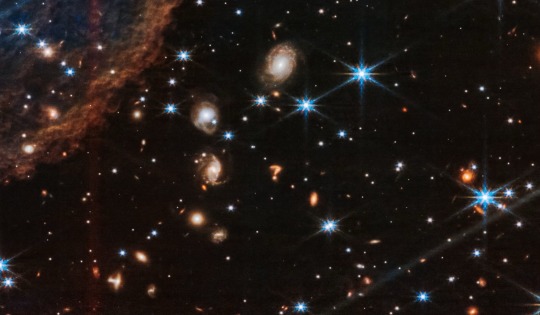
This glowing red question mark was captured in the background of a new image from the James Webb Space Telescope. Photograph By NASA, ESA, CSA
NASA Just Found a Question Mark in Space. What Exactly is It?
The object is far outside our galactic neighborhood, possibly billions of light-years away. But astronomers have seen similar objects closer to home.
— By Allie Yang | August 9, 2023
Two of our galaxy’s most famous stars were recently photobombed by what appears to be a celestial question mark.
The symbol was spotted in a new image from the James Webb Space Telescope (JWST) of the forming stars Herbig-Haro 46/47, which are well-known and have been frequently observed by astronomers. These two stars can provide clues about how our own sun may have formed. They’re relatively close to Earth, about 1,400 light-years, and relatively young, only a few thousand years old. In fact, they’re still in gestation and have not technically been “born” yet, which is marked when the stars start shining from their own nuclear fusion.
The image is the first of the twin protostars from the NIRCam instrument on JWST. It was captured using infrared light, which penetrates space dust more easily than visual light, and it is the highest resolution image of the objects ever seen at these wavelengths.
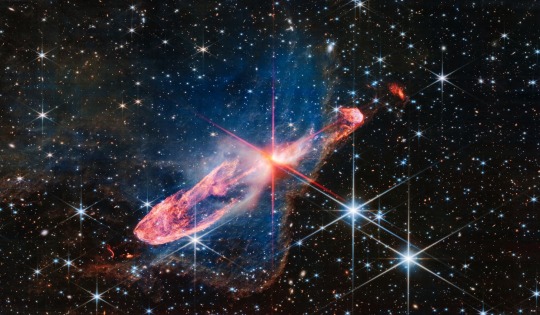
The two protostars are buried deep in the gas and dust that are being drawn in to add to their mass—look for them at the center of the red diffraction spikes. These stars are only a few thousand years old, and stars take millions of years to fully form. Photograph By NASA, ESA, CSA
The telescope’s astonishing sensitivity allowed the glowing red question mark to be captured in the lower center of the image. The object is far outside our galactic neighborhood, possibly billions of light-years away, says Christopher Britt, an education and outreach scientist at the Space Telescope Science Institute who helped plan these observations.
His best guess is that the question mark is actually two galaxies merging.
“That's something that's seen fairly frequently, and it happens to galaxies many times over the course of their lives,” he says. “That includes our own galaxy, the Milky Way … [it] will merge with Andromeda in about four billion years or so.”
The hints pointing to two galaxies are found in the question mark’s strange shape. There are two brighter spots, one in the curve and the other in the dot, which could be the galactic nuclei, or the centers of the galaxies, Britt says. The curve of the question mark might be the “tails” being stripped off as the two galaxies spiral toward each other.
“It's very cute. It's a question mark … But you can find the colons and semicolons, and any other punctuation mark, because you have 10,000 little smudges of light in each image taken every half hour,” says David Helfand, an astronomer at Columbia University. The sheer number of shining objects we find are bound to create some serendipitous images, and our brains have evolved to find those patterns, he says.
Astronomers have seen similar objects closer to home. Two merging galaxies captured by the Hubble Space Telescope in 2008 also look like a question mark, just turned 90 degrees.
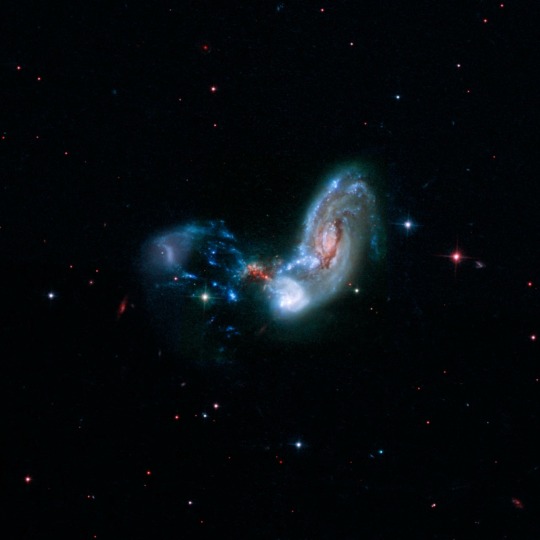
Merging galaxies can take on many mesmerizing shapes. These merging galaxies, known as II Zw 096, are the site of a spectacular burst of star formation that is hinted at in the red speckles near the middle of the image. Photograph By NASA, Caltech, H. Inami (Hiroshima University)

This image from the Hubble Space Telescope shows two spiral galaxies (Collectively Identified as Arp 256) in the early stages of merging. Notice its question mark-like shape. Photograph By NASA, ESA, The Hubble Heritage Team (STSCI/AURA)-ESA/Hubble Collaboration and A. Evans (University of Virginia, Charlottsville/NRAO/Stony Brook University)
Helfand says the question mark seems to be two objects, the curve and the dot, but could be more that just happened to line up. They could also be completely unrelated objects, he says, if one is much closer to Earth than the other.
Britt warns that estimating distance based only on colors in the image can be tricky. The red of the question mark could mean it’s very far away (light waves stretch as they travel through the expanding universe, shifting to redder wavelengths) or that it’s closer and obscured by dust near the object.
It would take more investigation to identify exactly how far away the question mark is. This could be done by measuring photometric redshifts, determined by the brightness observed through different filters, but this would only provide an estimate for the distance, Britt says. Spectroscopy, which analyzes light from the source to determine its elemental makeup, could provide a more exact distance but requires a separate instrument to measure.
Given the number of intriguing targets spotted by JWST, the question mark may never receive this treatment. For now the source of this symbol in the sky remains a cosmic mystery.
#NASA#Galactic#Billions of Light-Years#Galaxy 🌌#Allie Yang#James Webb Space Telescope (JWST)#NIRCam#NASA | ESA | CSA#Space Telescope Science Institute#Christopher Britt#Hubble Space Telescope#University of Virginia#Stony Brook University#Hiroshima University
3 notes
·
View notes
Photo

Çubuklu sarmal gökada NGC 5068'in James Webb Uzay Teleskobu'nun NIRCam aygıtından alınan bu görüntüsü, gökadanın parlak merkezi çubuğu boyunca en yoğun olan devasa yıldız popülasyonu ve içindeki genç yıldızlar tarafından aydınlatılan yanan kırmızı gaz bulutları ile süslenmiştir. Galaksinin bu yakın-kızılötesi görüntüsü, NGC 5068'in çekirdeğini oluşturan yaşlı yıldızların muazzam bir şekilde bir araya gelmesiyle doldurulmuştur. NIRCam'in keskin görüşü, astronomların galaksinin gazını ve tozunu dikkatle inceleyerek yıldızlarını yakından incelemesini sağlar. Yoğun ve parlak toz bulutları, sarmal kolların yolu boyunca uzanır: Bunlar, yeni yıldızların oluştuğu hidrojen gazı toplulukları olan H II bölgeleridir. Genç, enerjik yıldızlar etraflarındaki hidrojeni iyonlaştırarak kırmızıyla temsil edilen bu ışıltıyı yaratıyor.Kredi: ESA/Webb, NASA & CSA, J. Lee ve PHANGS-JWST Ekibi
#James Webb Uzay Teleskobu#NGC 5068#NIRCam#ESA/Webb#NASA & CSA#J. Lee ve PHANGS-JWST Ekibi#teşekkürler#H II
1 note
·
View note
Text

New research alert! With recent observations on NASA’s James Webb Space Telescope (JWST), Museum astronomers and collaborators have uncovered a complex atmosphere on a free-floating “super-Jupiter” that’s about 20 light years from Earth. First discovered in 2006, the object SIMP 0136 is about 13 times the mass of Jupiter and spins extremely fast: a full rotation is just 2.4 hours. Because it doesn’t orbit a star, it is not classified as an exoplanet, but SIMP 0136 could be a rogue planet or a brown dwarf, an object with a mass between planets and stars.
“SIMP 0136 has always been one of my favorite objects to study,” said Jackie Faherty, a senior research scientist in the Museum’s Department of Astrophysics and co-author on the new study, published recently in The Astrophysical Journal Letters. “From previous work we knew it was young, nearby, and low mass, and that the light from it varied widely. We suspected it was an object with turbulent weather patterns, but we needed JWST to help solve the mystery.” Read about the findings in our latest blog post.
Image: NASA, ESA, CSA, Joseph Olmsted (STScI)
#science#amnh#museum#natural history#did you know#fact of the day#space exploration#space#cosmos#planets#solar system#james webb space telescope#nasa#jwst
368 notes
·
View notes
Photo

2025 April 9
HH 49: Interstellar Jet from Webb Image Credit: NASA, ESA, CSA, STScI, JWST
Explanation: What's at the tip of this interstellar jet? First let's consider the jet: it is being expelled by a star system just forming and is cataloged as Herbig-Haro 49 (HH 49). The star system expelling this jet is not visible -- it is off to the lower right. The complex conical structure featured in this infrared image by the James Webb Space Telescope also includes another jet cataloged as HH 50. The fast jet particles impact the surrounding interstellar gas and form shock waves that glow prominently in infrared light -- shown here as reddish-brown ridges. This JWST image also resolved the mystery of the unusual object at HH 49's tip: it is a spiral galaxy far in the distance. The blue center is therefore not one star but many, and the surrounding circular rings are actually spiral arms.
∞ Source: apod.nasa.gov/apod/ap250409.html
189 notes
·
View notes
Text

JWST observed Herbig-Haro 49/50, a protostellar outflow where a still-developing star’s jet collides with surrounding gas, shaping intricate structures. A distant spiral galaxy, seen by chance, aligns in the background.
Credit: NASA, ESA, CSA, STScI
176 notes
·
View notes
Text
Interstellar Jets

This JWST image shows a couple of Herbig-Hero objects, seen in infrared. These bright objects form when jets of fast-moving energetic particles are expelled from the poles of a newborn star. (Image credit: NASA/ESA/CSA/STScI/JWST; via APOD) Read the full article
112 notes
·
View notes
Photo
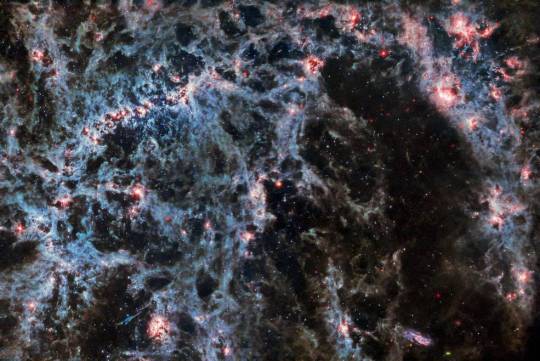
Çubuklu sarmal gökada NGC 5068'in James Webb Uzay Teleskobu'nun MIRI aygıtından alınan bu görüntüsünde, sarmal gökadanın tozlu yapısı ve yeni oluşmuş yıldız kümelerini içeren parıldayan gaz kabarcıkları özellikle belirgindir. Küçük mavi-yeşil-kırmızı noktalar olarak temsil edilen bu görüntüye üç asteroit izi giriyor. Asteroitler, teleskopa uzaktaki hedeften çok daha yakın oldukları için bunlar gibi astronomik görüntülerde görünürler. Webb, astronomik nesnenin birkaç görüntüsünü yakalarken, asteroit hareket eder, bu nedenle her karede biraz farklı bir yerde görünür. MIRI'den alınan bu gibi görüntülerde biraz daha belirginler, çünkü birçok yıldız orta kızılötesi dalga boylarında yakın kızılötesi veya görünür ışıkta oldukları kadar parlak değiller, bu nedenle asteroitleri yıldızların yanında görmek daha kolay.Kredi: ESA/Webb, NASA & CSA, J. Lee ve PHANGS-JWST Ekibi
#james webb uzay teleskobu#NGC 5068#ESA#ESA/Webb#NASA & CSA#J. Lee ve PHANGS-JWST Ekibi#teşekkürler#MIRI aygıtı
1 note
·
View note
Text
Is Alien Life Real? JWST’s K2-18b Discovery Might Just Blow Your Mind!

What’s K2-18b, and Why Should You Care?
K2-18b is a super-Earth—think Earth, but bigger, badder, and 8.6 times our planet’s mass. It orbits a cool red dwarf star in the habitable zone, where liquid water (aka life’s BFF) could exist. Discovered in 2015 by NASA’s Kepler mission, this exoplanet is 124 light-years away in the constellation Leo, zipping around its star every ~33 days.
The James Webb Space Telescope, aka the universe’s ultimate peeping Tom, is designed to snoop on distant planets’ atmospheres. Using its fancy spectrographs (NIRISS, NIRSpec, and MIRI), JWST analyzed starlight passing through K2-18b’s atmosphere and found some wild stuff:
The catch? The DMS/DMDS signals are at a three-sigma level (99.7% confidence), not the gold-standard five-sigma (99.99994%). Scientists need more data to be sure, but the levels detected—10 parts per million, thousands of times higher than Earth’s—are making jaws drop. As Professor Nikku Madhusudhan, the lead researcher, said, “This is the strongest evidence yet there is possibly life out there.”
Want the full scoop on how JWST pulled this off? Check out this epic article on James Webb Discovery!

Image: JWST’s spectra of K2-18b, showing peaks for methane, CO₂, and a tentative DMS signal. Credit: NASA, ESA, CSA, Ralf Crawford, Joseph Olmsted, Nikku Madhusudhan
But Wait, Is It Really Aliens?
Okay, before we start planning an interstellar road trip, let’s pump the brakes. The science community is super excited but also super cautious. Here’s the tea:
Skepticism Alert: Some researchers, like MIT’s Sara Seager, warn that “enthusiasm is outpacing evidence.” DMS can form without life, like in comets (shoutout to 67P/Churyumov-Gerasimenko) or through chemical reactions in hazy atmospheres.
Alternative Theories: K2-18b might not be a lush ocean world. It could be a mini gas giant with no surface or a magma ocean planet (aka a lava nightmare). Rude, right?
More Data Needed: The Cambridge team needs 16–24 more hours of JWST time to hit five-sigma certainty, which could happen in 1–2 years.
Why This Matters (Like, A Lot)
Plus, JWST is just getting started. It’s already eyeing other exoplanets like TRAPPIST-1e, and future telescopes (hello, Habitable Worlds Observatory!) will take us even closer to finding E.T. This is the kind of stuff that makes you stare at the stars and wonder, “What’s out there?”
29 notes
·
View notes
Text

Stunning new image of our galactic center from JWST! This is a star forming region 300 lyr from the supermassive black hole in the center of the Milky Way. Cyan represents emission from ionized hydrogen, and it’s got some unexpected features 👀
📸: NASA, ESA, CSA, STScI, S Crowe
#astrography#astronomers#astrophysics#astrophotography#astrology#astronomy#astro observations#astro notes#space station#space science#space exploration#outer space#space#hubble space telescope#james webb space technology#jwst images#jwst#nasa picture of the day#nasa photos#nasa#nasawebb#orion nebula#nebula#james webb space telescope#space photography#our universe#universe#spaceporn#galaxies#galaxy
394 notes
·
View notes
Photo

2024 November 26
The Sombrero Galaxy from Webb and Hubble Image Credit: NASA, ESA, CSA, STScI, Hubble Heritage Project (STScI, AURA)
Explanation: This floating ring is the size of a galaxy. In fact, it is a galaxy -- or at least part of one: the photogenic Sombrero Galaxy is one of the largest galaxies in the nearby Virgo Cluster of Galaxies. The dark band of dust that obscures the mid-section of the Sombrero Galaxy in visible light (bottom panel) actually glows brightly in infrared light (top panel). The featured image shows the infrared glow in false blue, recorded recently by the space-based James Webb Space Telescope (JWST) and released yesterday, pictured above an archival image taken by NASA's Hubble Space Telescope in visible light. The Sombrero Galaxy, also known as M104, spans about 50,000 light years and lies 28 million light years away. M104 can be seen with a small telescope in the direction of the constellation Virgo.
∞ Source: apod.nasa.gov/apod/ap241126.html
181 notes
·
View notes
Text

JWST has captured Neptune’s auroras for the first time! The most distant planet from the Sun has a magnetic field tilted at a strange 47-degree angle, causing auroras away from its poles. Webb also found Neptune’s upper atmosphere has cooled by hundreds of degrees—likely why its auroras remained undetected for so long.
Credit: NASA, ESA, CSA, STScI
19 notes
·
View notes
Text
A Stellar Look at NGC 602
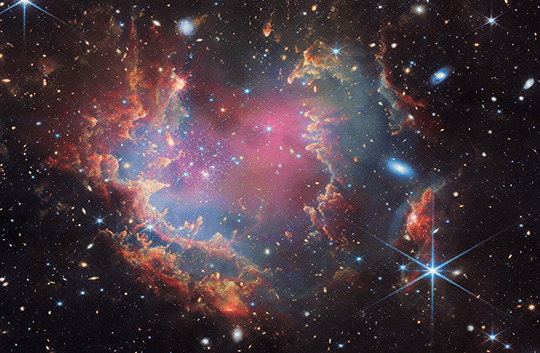
The young star cluster NGC 602 sits some 200,000 light years away in the Small Magellanic Cloud. Seen here in near- and mid-infrared, the cluster is a glowing cradle of star forming conditions similar to the early universe. (Image credit: NASA/ESA/CSA/JWST; via Colossal) Read the full article
97 notes
·
View notes
Text

An article published in the journal "Nature" reports the discovery of three ultramassive galaxies in the early universe in which stars are forming with an efficiency almost twice that of galaxies of average mass by the standards of that era. A team of researchers coordinated by the University of Geneva (UNIGE) used observations conducted with the James Webb space telescope within the FRESCO program. The three galaxies (Image NASA/CSA/ESA, M. Xiao & P. A. Oesch (University of Geneva), G. Brammer (Niels Bohr Institute), Dawn JWST Archive), which were cataloged as S1, S2, and S3, are almost as massive as the Milky Way and add to others that were discovered in recent years and are difficult to explain with the most accepted cosmological models, starting with lambda-CDM.
19 notes
·
View notes